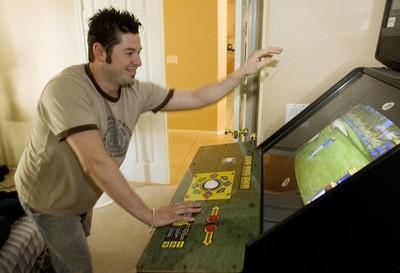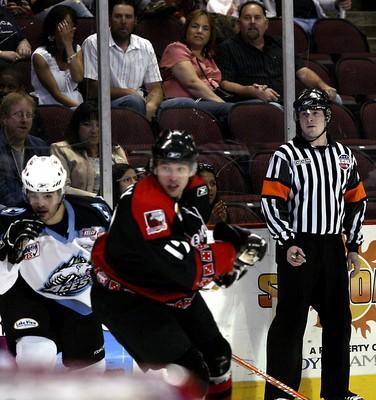Official’s not just skating through


It was every hockey referee’s worst nightmare.
The Fresno Falcons were on the power play, working the puck around for a clear shot at the Las Vegas Wranglers’ goal. Suddenly, the pass was intercepted and one of the Wranglers was on a breakaway.
Adam Hendren saw what was happening. He was at the goal line by the Wranglers’ net and there was no way he could outskate Nick Anderson, who had a 60-foot head start. However, Hendren churned his way up the ice and linesman Chad Wiener covered for him as Anderson came in on goal and shot.
Anderson didn’t score and Hendren was bailed out. But it is one of those occupational hazards that every referee deals with when he works a three-man system in the ECHL.
Hendren, 26, recently completed his first season at professional hockey’s Double-A level. His work was good enough that he was rewarded with a first-round playoff series. If he’s good enough to eventually get to the National Hockey League, he won’t have to worry about being caught up ice since the NHL uses a two-referee, two linesman system and Hendren would be responsible for covering only half of the ice.
“It’s very competitive,” Hendren says of his attempt to reach the top of his profession. “I’ve been doing every single thing amateurwise. I’ve hit every rung on the ladder. Last year, I was working 120 games in seven or eight different leagues.
“I felt I did a good job this year. The speed of the game was made for a four-man system. It’s harder with a three-man system. But (this) is the place to learn and get better,” he said.
A hockey referee will skate between 10 to 12 miles during a regulation 60-minute match.
Unlike the players who get to catch some rest on the bench during shift changes, Hendren remains on his feet the entire time.
He has to keep himself in top shape. Hendren gets to the arena a couple of hours before the opening faceoff, then spends some time jumping rope, riding a stationary bicycle, lifting weights or running on a treadmill.
He’ll also watch video of the teams to make sure he’s prepared for any possible trouble.
“If there’s a history between two teams, it’s good to know about it,” Hendren said. “You want to be able to defuse any situations before they escalate.”
The night he was working the Wranglers-Fresno game, Brian McConnell of Fresno and the Wranglers’ Adam Cracknell decide to drop the gloves with 6 1/2 minutes to go in the first period.
The 3,429 fans inside the Orleans Arena love it as the two players trade punches. Hendren is keeping a close eye on the proceedings, allowing the two combatants to get the anger out of their system.
Finally, his linesmen step in, separate McConnell and Cracknell and escort them to their respective penalty boxes. Each receives five minutes for fighting. But that is the last time Hendren has to administer a major penalty. It’s back to hockey, and it stays that way through the shootout, in which the Wranglers prevail, 5-4.
Hendren says because his linesmen did such a good job with the fight, it sent a message to the two teams that the guys in the striped shirts were in charge, and that had a lot to do with there not being any more incidents.
“You have to have a lot of trust and a lot of faith with the guys you work with,” Hendren says of linesmen Wiener and Wally Lacroix. “If they weren’t good, they wouldn’t be here.”
Having played hockey, Hendren understands that tempers flare. Rather than immediately break up that particular fight, he thought it would be better in the long run if McConnell and Cracknell finished what they started rather than have things linger and perhaps affect the game later.
Hendren knows what it will take to reach the NHL. He has to skate better. He has to gain experience. He has to be in position to make the right calls.
Bryan Lewis, the ECHL’s officiating consultant, watched Hendren work twice this year. He liked what he saw.
“He’s about the future,” says Lewis, who worked in the NHL for 35 years. “Adam’s a guy we’re counting on to do a full complement of games.”
Lewis says he was pleased that after Hendren’s ECHL assignments were complete he didn’t go on vacation. Instead, Hendren worked United States Hockey League games and tournaments for USA Hockey, the sport’s governing body.
“I like his attitude,” Lewis says. “He’s no different from a player. He wants to move up and his working the USHL playoffs showed me something about how serious he is. You can’t question his dedication. He’s got a big learning curve, and the more experience he gets the better official he will be.”
Hendren takes his quest seriously. He has never missed a game, even after the time he drove his car into a ditch trying to make his way through a Montana snowstorm.
“I watch what I do on and off the ice,” he says. “Especially off the ice, because it’s the off-ice antics that can get you. You never know who is watching. That’s why you put in an honest effort every time. You have to give 100 percent.
“I really want this. That’s why I’m giving it my best shot. If it doesn’t work out, at least I did everything I could to make it happen.”
Hendren graduated from Western High School, attended UNLV for a year, then decided to quit school to become an NHL referee. As a teenager, he had played forward for the Las Vegas Gamblers. He plays recreationally on Monday nights.
He never gives the guys who referee his games any grief, though.
“Oh no,” Hendren says. “I would never show up anyone like that.”












